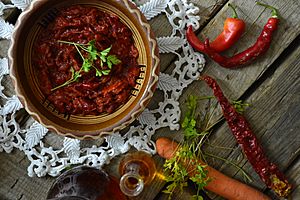Ljutenica facts for kids
 |
|
| Type | Spread, salad, relish |
|---|---|
| Region or state | Balkans |
| Associated national cuisine | Bulgarian, Macedonian, Serbian |
| Serving temperature | Cold |
| Main ingredients | Peppers, tomatoes, garlic, onions, vegetable oil |
Ljutenica (pronounced lyoo-teh-NEE-tsa) is a tasty vegetable spread or relish. It's very popular in countries like Bulgaria, North Macedonia, and Serbia. The name lyuto or luto means "hot" in some of these languages, hinting that it can sometimes be spicy!
Ljutenica is often served cold. People enjoy it as a spread on bread, a side dish with meals, or even as a dip. It's a common part of meals in the Balkans region.
What's in Ljutenica?
Ljutenica is made from a mix of fresh vegetables. The main ingredients usually include:
- Peppers (like bell peppers)
- Tomatoes
- Garlic
- Vegetable oil
Other common ingredients can be aubergines (also known as eggplant), carrots, sugar, and salt. These ingredients are cooked down to create a thick, flavorful spread.
Different Kinds of Ljutenica
There are many ways to make Ljutenica, so it comes in different styles:
- Smooth or Chunky: Some versions are blended until very smooth, like a paste. Others are left a bit chunky, so you can still see small pieces of vegetables.
- Spicy or Mild: Depending on the type of peppers used, Ljutenica can be hot and spicy or mild and sweet.
- With Chili or Eggplant: Some recipes add chili peppers for extra heat. Others include more aubergine for a richer flavor and texture.
Where Does Ljutenica Come From?
Ljutenica is a traditional food from the Balkan region. It's a staple in Bulgarian, Macedonian, and Serbian cooking. Families often make large batches of it at home, especially after the summer harvest when vegetables are fresh.
In recent years, more and more companies have started making Ljutenica in factories. This has helped make this delicious spread famous in many other parts of the world, beyond the Balkans.
See also
 In Spanish: Lutenica para niños
In Spanish: Lutenica para niños

